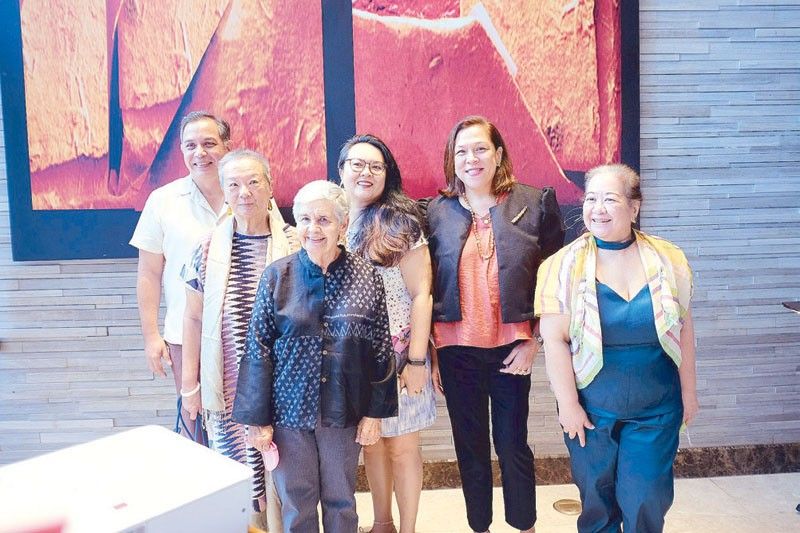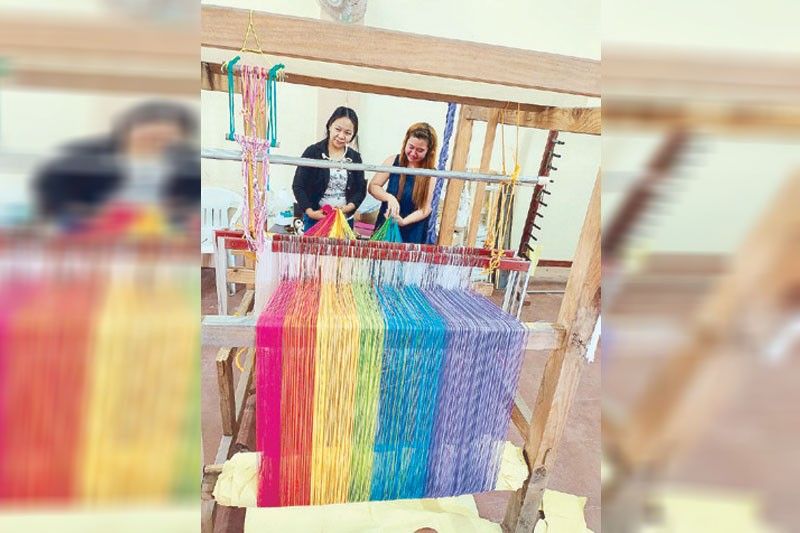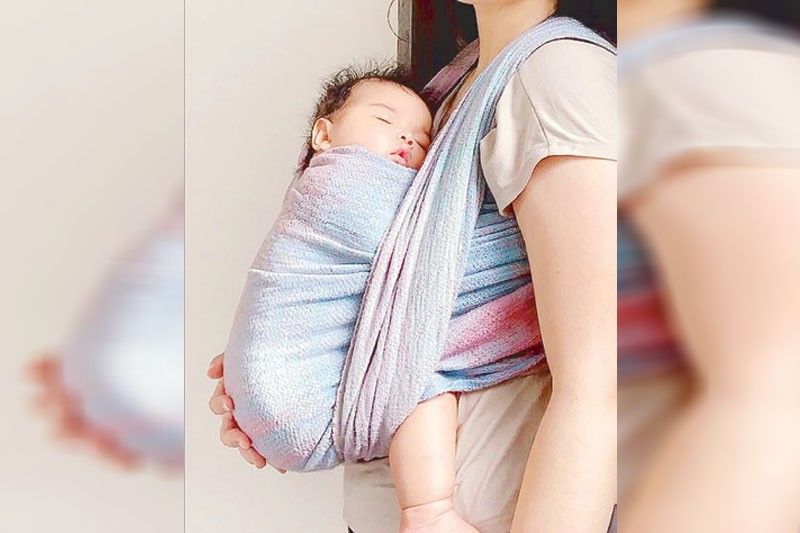Weaving heritage and elegance

A mom’s personal search for a quality baby carrier led her to discover and fall in love with the centuries-old art of weaving.
For Jeannie Laccay, “baby-wearing” via a woven carrier not only helps with just about anything — from babies’ health to their mood — it also lets her accomplish daily chores while knowing her baby is safe and happy. Also, “wearing” a baby can allow you to go places strollers can’t.
Sadly, she couldn’t find a baby carrier that was versatile, durable, comfortable, and weather-suitable. Jeannie’s search fail prompted her to make one.
She first consulted Prof. Google and learned the basics via tutorial videos online. She consulted master weaver Josie Garlitos of the Philippine Textile Research Institute, which taught her the know-hows of weaving, from the raw materials to the finished products.

Soon, she found herself immersed in the craft. Not only did she make her own baby carrier, she also turned it into a passion project.
In fact, in 2018, Jeannie established Aruga Handwovens. Aruga is a Filipino word that means “tender care.”
“At first, I did everything, from the production to marketing and selling,” she shared.
When the pandemic hit, her personal passion became the community’s.

A native of Dupax Del Sur, Nueva Vizcaya, Jeannie trained a small group of weavers to provide livelihood for her community and bring back the lost art of Isanay weaving in her tribe.
And so, from weaving baby wraps and carriers, Aruga Handwovens has expanded to different woven products.
Check out Aruga Handwovens’ latest collection at the 12th Likhang Habi Market Fair, which is ongoing until tomorrow, Oct. 16, at Glorietta Activity Center.
Woven Wonders
Aruga Handwovens is one of the 60 exhibitors featured at the ongoing 12th Likhang Habi Market Fair.
A project of The Philippine Textile Council, the annual (physical) fair is back after two years showcasing the country’s woven wonders, from hand-woven fabrics to ready-to-wear clothes, home accessories, and even locally made furniture and pottery.
The Glorietta Activity Center was transformed into an outdoor souk by event stylist Kitty Bunag.
“Sampayan is the theme of the whole setup,” shares project head Mia Villanueva. “So all the textiles will be hung on dried ornamental trees.”
Showcased during the thee-day fair are homegrown brands Abek Home & Culture, Abre Linea, Accelerate Sulu, Adante Leyesa, Aishe Fashion, Angie’s Yakan Handloom Weaving, Anihan sa Ibaan, Aruga Handwovens, Balud Craft, Bicol Sweetgrass Handicrafts, Camisa Amana, Cariñosa, Casa Garcia, Coco & Tress, Crafted Pilipinas, Creative Definitions, Ditta Sandico, En Barong Filipino, Gifts and Graces, Habi, Helena Alegre Sculptural Jewelry, Idyllic Summers, Ifugao Nation, Iraya Mangyan Art, Jor-El Espina, Kalinga Weaving, Kaya Mana PH, Knitting Expedition, La Bonne Vie, La Herminia, Lakat Sustainables, Local Home+Art+Fashion, Mabaysay, MCV Designs, Milvidas, Monica Madrigal, Narda’s Nina Abel, Pidayit, Piesa, Pina Seda Primera, PNay, Provenciana, Raquel’s Piña Cloth Products, Ruby Roa with Lila Lifestyle, Rurungan Collective, Siegrid Bangyay Pottery, Silahis Arts and Artifacts, Style Isle, Tadeco Home, The Manila Collectible Co, Tinampuso, Tuwas Yakan Weavers, WeaveManila Inc., Woven, WVN Living, and WYC Wear Your Culture.
The search is on for the best piña and abaca weavers
The annual fair not only provides countless Filipino artisans all over the country with a viable and steady market to sell their handwoven products — made from cotton, piña, abaca, and nito — but also to revive and promote the art and craft of hand-weaving.
Likhang Habi also happens to be the only fair of its kind that stages the annual Lourdes Montinola Piña-Weaving Competition.
“Starting this year, we’ve also added the Eloisa Hizon Gomez Abaca Competition to its roster of fair-related activities,” enthuses HABI president Adelaida Lim during the fair launch held at Holiday Inn Makati. “In the past, so many young weavers joined the piña-weaving competition, which is good. It’s an assurance that the weaving traditions in the country will continue.”
For this year’s competitions, contestants will be judged by a panel of experts on Philippine textiles, processes, and materials.
“This is the fifth year we’re holding the piña competition. And since we’ve had it, we’ve noticed that artisans working on piña have been leveling up,” adds Lim.
Council member Mike Claparols of Lakat Sustainables shared that Habi’s greatest contributions include encouraging weaving communities to use cotton and educating the public about the painstaking art form that is hand weaving.
“A lot of consumers think that hand-woven fabrics are too expensive. Many try to bargain with weavers by asking for big discounts. What they don’t know is that weaving is a learned skill that requires time and dedication to master.”
Mabuhay ang habi!
The three-day fair is Habi’s biggest and most talked about fundraising activity. Aside from direct donations from individuals and companies, the fair is one of the main sources of funding for the council’s projects, which includes preservation of the art of weaving, educating consumers, and pushing locally made products and artists to the national — and global — market.
“As a country, we carry important fibers like piña and abaca that are uniquely ours,” says Habi: The Philippine Textile Council chairperson Maribel Ongpin. “Habi has managed to raise consciousness about the value of hand-weaving and these native fibers. And while we’re at it, I would like to give importance to abaca, which is the strongest fiber in the world.”
She also took the opportunity to campaign against the polymer currency (P1,000 bank notes) that the Central Bank has released.
“Not only did they remove abaca, they put an artificial material that is not worth what they say it is. It’s not antibacterial. They also say it can’t be counterfeited. That’s not true. And so, as a matter of patriotism, as a matter of standing up for our indigenous fabrics and fibers, I urge everyone not to accept the new polymer currency. Return it to the bank and ask the teller to give you something else,” the feisty Ongpin says.
* * *
For inquiries, call 0921-8496974 or email support@habiphilippinetextilecouncil.com.



















